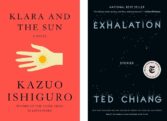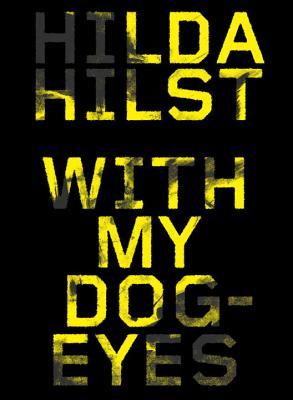
by by Margaret Kolb

Published by Melville House, 2014 | 96 pages
In 1966, shortly after the coup d’état that overthrew her then-president João Goulart, Brazilian novelist, poet, and playwright Hilda Hilst (1930–2004) retired to a secluded estate in Casa do Sol in the country’s southeastern region, a two-hour drive from São Paulo and the Atlantic. In this idyllic environment Hilst nurtured the talent of several protégés, took on a couple lovers, filled her house with dogs, and composed a series of legendary avant-garde texts. Over the past few years, several of these works—alongside a flurry of masterpieces by her friend Clarice Lispector (1920–1977)—have finally been made available to English-language readers. Adam Morris’s translation of Hilst’s With My Dog Eyes is but the latest contribution to this most welcome reclamation of two of the central names in 20th-century Brazilian literature.
With My Dog Eyes concerns a middle-aged mathematics professor named Amós Kéres who, as the novel begins, is being dismissed from his teaching post. “There are obvious signs of wandering off,” his superior informs him. “Sentences that break off and only continue after fifteen minutes[.] Professor Kéres, fifteen minutes is too much.” Kéres, we quickly learn, is in the midst of an existential crisis.
Kéres’s most ardent wish, his idée fixe, is to develop a mode of thinking—an algebra of symbolic logic—that would describe and account for, with mathematical rigor, all the complexity and chaos of human experience. He recalls, as a young boy, wanting nothing less than to find “a short and harmonious equation that would scintillate the as-yet unexplained.” Kéres’s efforts are a fictionalization of a real-world tradition, with a long history of its own. The attempt at developing a general or abstract science of reasoning goes back at least to René Descartes (1596–1650) and Gottfried Wilhelm Leibniz (1646–1716). More recently, Gottlob Frege (1848–1925) did pivotal work, as did Bertrand Russell (1872–1970), whose essays on the philosophy of mathematics explicitly influenced With My Dog Eyes. Kéres’s dream, his obsession, is to complete the project that these thinkers began, to complete the age-old pursuit of what, in his “Study of Mathematics,” Russell called the “world of pure reason,” which “knows no compromise, no practical limitations, no barrier to the creative activity embodying its splendid edifices.”
It is clear, however, from the first pages of With My Dog Eyes, that Kéres is already, at least unconsciously, aware of the futility of his endeavor. An obvious interpretation of the work as a whole, in fact, is that the entire narrative occurs within one of Kéres’s anxious reveries, provoked by this awareness. Our (anti)hero, in his own telling, is less the paragon of logical rigor that the austerity of his vocation would suggest, and more an intellectual anarchist overcome by a throbbing impulse to implode the paradigms that have regimented his life. Failing to achieve his project of mathematical unification, he instead sees only fragmentation and fracture. In response to this disarray he renounces the “madness of the Search” for a pure logic of existence, which he now descries as “the obscuring, incarnate illusion of finding and understanding.” The narrative of Hilst’s text manifests this fragmentation formally. “I’m melting the measure / I created,” reads one of a number of poems that litter the text, occupying a liminal space between conscious and unconscious thought. “Blotting the lines: / Circles / That all around me I drew.”
Regardless of the ultimate nature of Kéres’s despair, he is, at least in the dream-thoughts that comprise the narrative of With My Dog Eyes, isolated and misanthropic. “What a sham all this of kids and marriage,” he thinks in the middle of a fight with his wife as his son cries at his feet. “I think of a shot in the chest and the other one’s still ranting eternally in her light-green nightgown… A shot in the chest.” Elsewhere he appears, briefly, to be one of those lecherous professors we find in Nabokov and Roth: “Get drunk every night, and vicious, sputtering, shake my dick timetotime for [his wife] Amanda’s friends.” However, bodies remain alien to Kéres throughout the text, whether as a site for violence or intimacy. His attempts at eroticization are exclusively impersonal, demeaning, and unfulfilling. During one reverie of a brothel he frequented in his twenties, his mother suddenly enters, shaming his desires through her presence: “I’ll go wherever you go, son,” she implores him. “There should be room to plant some collards in the back.”
And yet, though the specific sensory “experience” of With My Dog Eyes is indeed that of a mind jettisoning out of its natural orbit, losing the coordinates that had heretofore organized its existence—and many critics have described the arc of the novel as a descent into madness—the book is no simple study into neurological disorder, and to pigeonhole it as such is to do it a great disservice. The narrative seems to be more intentional inquiry on Kéres’s part of his own state of mind, rather than stream-of-conscious overflow of genuine mental illness. We see hints of this dotted throughout the text, as moments of perspective, hope, and sociality arise in his thoughts: “Amanda and the kid… I should have told them about the dark-gray despair streaked in black, a viscous substance taking me.” For Hilst, whose father suffered from schizophrenia and spent time living in mental institutions, With My Dog Eyes functions not as a representation of entropic breakdown, but instead as an investigation into the psychological response to the recognition of the irreconcilability of the two worlds Kéres desires to reconcile: the ideal world of mathematics and the chaotic world of nature and human experience.
Early in the novel Kéres asks: “What are feelings anyway? How is it that they vanish without a vestige? Were they ever there? Everything leaves a trace. In death, bones, later ashes. Vestiges in an urn.” Much that is essential to Hilst’s novel is contained in these lines. We as readers trail just behind Kéres’s narration, pursuing the line of ash left by each sensory instant of his contemplations. Kéres gives these moments a name when he calls them “sunburst[s] that w[ere] not fire.” With My Dog Eyes rolls along to the rhythm of their pulse, follows the ash-trace of their path as it leads gradually, and yet inevitably, to the blasted pastoral of the novel’s ominous endgame: windswept plains, a tree, and a man waiting to die.
Marcus Creaghan is a graduate student at the University of Toronto. He is interested in contemporary Spanish-language and postmodern literature.















click to see who
MAKE Magazine Publisher MAKE Literary Productions Managing Editor Chamandeep Bains Assistant Managing Editor and Web Editor Kenneth Guay Fiction Editor Kamilah Foreman Nonfiction Editor Jessica Anne Poetry Editor Joel Craig Intercambio Poetry Editor Daniel Borzutzky Intercambio Prose Editor Brenda Lozano Latin American Art Portfolio Editor Alejandro Almanza Pereda Reviews Editor Mark Molloy Portfolio Art Editor Sarah Kramer Creative Director Joshua Hauth, Hauthwares Webmaster Johnathan Crawford Proofreader/Copy Editor Sarah Kramer Associate Fiction Editors LC Fiore, Jim Kourlas, Kerstin Schaars Contributing Editors Kyle Beachy, Steffi Drewes, Katie Geha, Kathleen Rooney Social Media Coordinator Jennifer De Poorter
MAKE Literary Productions, NFP Co-directors, Sarah Dodson and Joel Craig